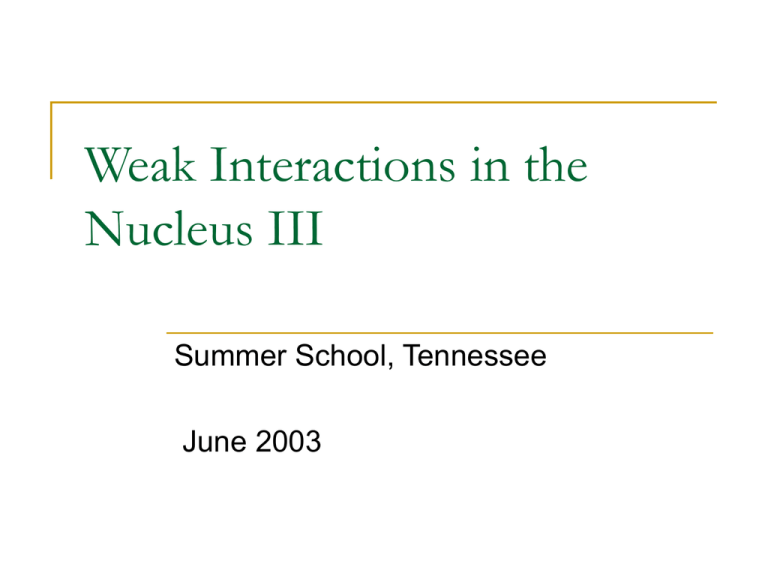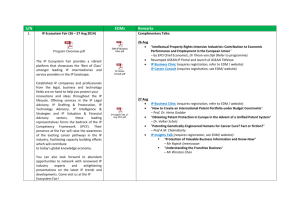Weak Interactions in the Nucleus III Summer School, Tennessee June 2003
advertisement

Weak Interactions in the Nucleus III Summer School, Tennessee June 2003 P, C and T Unlike the continuous transformations, these are not associated with additive quantum numbers, but multiplicative ones, if any. x x p p P: L L S S exmpl: P( ) P( ) In L=0 state P, C and T Charge conjugation the Dirac equation with E&M interaction exhibits a symmetry: (i e A m) 0 (i e A m) c 0 We now know that all particles have associated antiparticles that have opposite charge and identical other quantum numbers. How do we obtain the operator C * such that: c C C i 2 (i e A m) 0 * * * (i e A m) 0 We need: C *C 1 P, C and T Charge conjugation example: 0 1 0 imt 4 E<0 e Spin-down e N 0 1 i 0 1 0 0 imt 1 0 imt 1 e e 0 0 N 0 0 1 0 E>0 - 0 i 0 2 4* i N 0 i 0 0 0 i i 0 0 0 Spin-up e+ P, C and T Charge conjugation symmetry clearly broken by Weak Interaction H ( e - ) H ( e+ ) P, C and T Time Reversal x x p p T: L L S S Example of construction: 1 TpT p T K? 1 TxT x but how about S? 1 x y z x y Need to include in addition iS y / iS y / x y z K(s , s , s ) K (s , s , sz ) S e ( s , s , s )e ( sx , sy , sz ) Time Reversal Wigner showed that it needs to be anti-unitary T UK CP-violation and matter-anti-matter asymmetry CP-violation so far observed in K decays could be explained by a (non-trivial) phase in the CKM matrix But this is not enough to explain the matter-anti-matter asymmetry presently observed in Universe. CP-violation and supersymmetry Supersymmetry predicts CP violation observables larger than predicted by SM. For example, in the scenario that supersymmetry will appear at the next run in the LHC: unless large suppressions are at work, the EDM should be on the order of 100 below the present limit. Expensive to pick up a phase in the Standard Model: u c t d ' s' b' e+ d c d ne W e+ ne W u W s u According to the Standard Model it is very hard to observe TRIV in nuclear Weak decays Cheaper to pick up a phase in extensions of the Standard Model: Example: Lepto-Quarks d e+ ne e+ W u d LQ u ne Detecting D: problems and solutions Problem Solution 1) neutrino too hard to detect 1) Detect proton instead 2) proton energy less than 1 keV: too hard to detect 2) accelerate protons to 30 keV. 3) potential systematic effects may require information on position of electron pn pe p p J . pe pn J . p p pn 3) use plastic scintillator and detect amplitude and time on both ends. p energy First phase of emiT: PRC 62, 055551 (2000). time between p and e p energy Second phase of emiT: presently running. time between p and e emiT published first results in 2000 that yielded D=0.61.2(stat)0.5(syst) x10-3 and is now running an upgraded version that should yield D<310-4 Electric Dipole Moment Existence of EDM violates Time-Reversal symmetry: x x p p T: L L S S EDM operator does not flip sign under T: d rq i i q q j j T: E E B B But for a non-degenerate system: d gd J gM J i Electrons, nuclei and atoms are non-degenerate systems, consequently a non-zero d implies violation of T. Electric Dipole Moment Existence of EDM violates Time-Reversal and P symmetries: x x p p P: L L S S EDM operator does flip sign under P: d rq i i q q j j P: E E B B But for a non-degenerate system: d gd J gM J i Electrons, nuclei and atoms are non-degenerate systems, consequently a non-zero d implies violation of P. Electric Dipole Moment The operator for EDM: d rq i i does not flip sign under T. i But the eigenvalue does: d d d T d T Naively: EDMs on composite neutral systems (e.g. atoms) cancel out. 1) Schiff showed that this is incorrect because of the finite size of the atom nuclear charge density ≠ dipole-moment density. Suppression factor = (Z nuclear size/atom size)2 2) Sandars (relativistic effects; contribution from electrons): EDM(atom) α Z3a2 EDM(e) enhancement 103 for Tl 3) Sandars : In polar molecules field at atom can be much larger than external field. Enhancements 103 Neutron EDM; Ramsey, Dress et al. Phys. Rep. 43, 410 (1978). Neutron EDM; Ramsey, Dress et al. Phys. Rep. 43, 410 (1978). Simplified version analyzer polarizer incoming neutrons /2 pulse B field /2 pulse Neutron EDM; Ramsey, Dress et al. Phys. Rep. 43, 410 (1978). From Rosenberry and Chupp, PRL 86, 22 (2001). d(129Xe) = 0.7±3.3(stat)±0.1(syst) x 10-27e cm. Present limits on EDM’s d(n)<6.3 10-26 e cm, PRL 82, 904 d(e) <1.6 10-27 e cm, PRL 88, 071805 d(199Hg)<2.1 10-28 e cm PRL 86, 2506 Large potential enhancement in nuclei Haxton, Henley, PRL 51, 1937 (1983). Spevak, Auerbach, Flambaum, PRC 56, 1357 (1997). Engel, Friar and Hayes, PRC 61, 035502 (2000).




